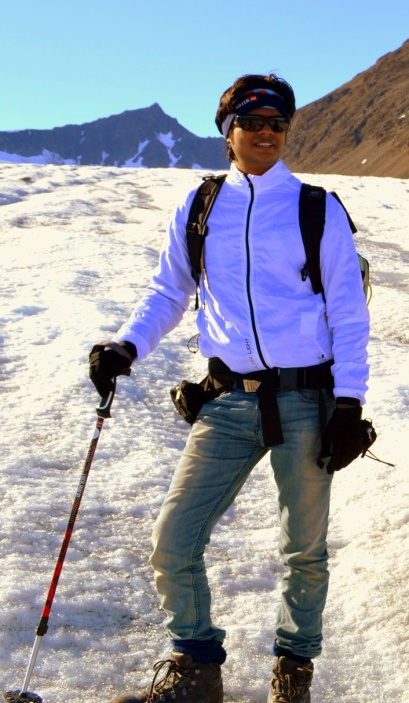 My name is Shridhar and I live in Incredible India!
My name is Shridhar and I live in Incredible India!
I'm a polar geospatial scientist in the making, as I've just finished my doctoral research this year.
My journey to the "cryospheric wilderness" started in 2009 when I joined as a research fellow at the Polar Remote Sensing Division of the National Centre for Antarctic and Ocean Research (NCAOR), India. I have always been attracted to subjects that relate to remote regions of the planet, where field campaigns are difficult if not impossible. The combination of science and technology to be applicable to understand Earth's cryosphere, as remote sensing does, truly sparked my interest which has led me to pursue a doctoral degree in the area of geospatial applications in the cryosphere.
My Ph.D. thesis has addressed a vital issue in geospatial science, including development and implementation of four new methods for rapid geo-information extraction in polar regions such as cryospheric land cover features, lakes, supraglacial streams, blue ice regions, and polar vegetation. I have not only developed new geospatial methods but also validated them with the ground truth data. I have participated in three major field expeditions to Antarctica (austral summers of 2011-12, 2013-14, 2014-15) and one field campaign to Arctic during (2015). Over eight months in Antarctica and 40 days in the Arctic, I collected essential ground truth data for validation of geo-information (e.g. glacier surface facies, polar vegetation) derived using remote sensing. The major contribution of my Ph.D. thesis truly marked the Latin term "Terra incognita is no longer incognita!" by Ptolemy's Geography (c. AD 150), by precisely mapping unmapped/poorly mapped regions of Antarctica using remote sensing techniques. This is probably the first Indian PhD in the field of Antarctic geospatial applications using very high resolution WorldView-2 satellite data, a growing field with international interest.
Apart from my doctoral study, I have been active in Arctic glaciology research since 2014 when I won the International Society for Photogrammetry and Remote Sensing (ISPRS) imagery contest (2013-14), providing me free DMCii satellite imagery to study surface accumulation and ablation facies of selected Arctic glaciers. Consequently, I participated in a field campaign to Ny-Ålesund, Svalbard in July ─September 2015 to measure "in situ" spectra of variety of glacier facies using ASD FieldSpec-4 spectroradiometer. My research in the Arctic deals with the spectral characterization of glacier facies using VHR multispectral image analysis to infer information about climate change. The broad objective of this study is to measure how selected glaciers have been changing in the past few decades and what their present response is. Preliminary results of this research have been presented in the Arctic Science Summit Week (ASSW)─2017, at Prague, Czech Republic and I aim to present the progress of my research in the upcoming Polar2018 in Davos.
Since I was relatively new to research in the Arctic, I wanted to get involved with an Arctic organization working at the international level, where I could contribute my Antarctic science experience while also gaining significant knowledge about Arctic research. This was the motivation for me to apply for IASC fellowship and to get actively involved in the IASC activities through Cryosphere Working Group (WG). The IASC Fellowship is now acting as a platform for me to get involved in leading-edge scientific and organizational activities, including discussions on the 5-year work plan of the IASC Cryosphere WG, annual allocation of funds for various WG activities, and upcoming workshops/snow schools. Therefore, I would strongly recommend this Fellowship for early career researchers (ECRs) to gain important insights into the working details of IASC. Scientifically, the IASC Fellowship is an excellent position to improve my Arctic research activities through suggestions and productive discussion with WG members, which I hope will evolve into long term collaborations. Ultimately, my involvement in the Cryosphere WG represents the contribution of an ECR in promoting IASC’s mission in India and internationally, which I hope in turn will motivate other ECRs to contribute to this mission, too
"Terra incognita is no longer incognita!" Shridhar D. Jawak, 2017 Cryosphere WG Fellow
- Details
